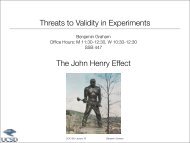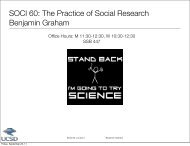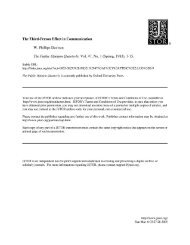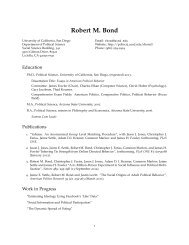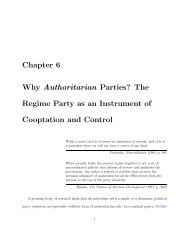Popkin-Reasoning Voter-Ch 3.pdf
Popkin-Reasoning Voter-Ch 3.pdf
Popkin-Reasoning Voter-Ch 3.pdf
Create successful ePaper yourself
Turn your PDF publications into a flip-book with our unique Google optimized e-Paper software.
*<br />
,6<br />
<strong>Ch</strong>apter Three<br />
and interest in the electorate, party<br />
idfit-Uficarion is profoundly politic4l.38 And when we accept the political<br />
don is no longer whether issues matter,<br />
but whether it is new or old issues that matter.<br />
Party Images<br />
There are t@k from contemporary performance, in<br />
aEaition to actual changes in party identification. One of them affects<br />
voters'views of fto-:ggUlP .<br />
ffier aFects views of how well parties pe{orm ditrerent tasks of gover-<br />
flation, and crime. Unfortunately, preoccupation with the argument over<br />
whether party is a purely psychological identification or a political yardstick<br />
has led academics to concentrate on changes in party identification,<br />
when Republicans or Democrats became independents or identified with<br />
the other party, and when independents began to identify with one of the<br />
parties.<br />
<strong>Ch</strong>anges in voters' party identification are genglSllv slq,w, often even<br />
glu.iulr t<br />
handle ilifferent plgblemwr whaClroups the parties stand for, can be<br />
l6-teprerent different groups or handle different tasks are generally based<br />
on issue-party assessments. Today, these party assessments are generally<br />
fiEsured by asking voters questions like "Which party cares more about<br />
farmers?" or "Generally speaking, which party do you think is better at<br />
'controlling inflation'?" I call these measures "party heats," for they<br />
directly assess the comparative advantages of parties on an issue; such<br />
questions are now a staple of public opinion research.<br />
Responses to these questions reflect feedback from political performance<br />
to a voter's conceptions of the parties which are not immediately reflected<br />
in party identification. For example, a poor performance on inflation by a<br />
Democratic president may weaken many working-class Democrats' faith in<br />
the ability of their party to deal with inflation. This may lead them to vote<br />
for Republican presidents when inflation looms, but they may not change<br />
their minds about which party's ultimate views of the good society are<br />
most compatible with their own.<br />
Analysis of party images shows that voters reason about the relative abil.<br />
ity of partieslo deal with different issues. They do not assume that the same<br />
party is uniformly good at representing all groups or dealing with all issues.<br />
ti<br />
Gotng without Data<br />
lrr 1988, for example, Americans by two to one thought Democrats were<br />
lrcncr able to protect social Security. By two to one, they also thought<br />
Itt'Pttblicans were better at controlling inflation and maintaining a<br />
tll'ong defense. In general, Democrats are considered better at protecting<br />
\ot'ial security, lowering unemployment, ensuring minority rights, and<br />
;ttt'scrving the environment; Republicans are considered better at con-<br />
Irolling inflation, maintaining a strong national defense, and fighting<br />
r t llrtc. se<br />
lrr chapter 2, I noted the irony of Voting'sspectacularly inaccurate predic-<br />
lkrrrs about the possibility of a "woman's vote" or a "senior citizen,s vote.,,<br />
Morcover, the views of American adults about the relative merits of the<br />
wills parties A..ut *itft *o-.", ryen, and senior citizens demonstrate just<br />
Itow able voteri are to -ake ois@ about the parties<br />
(rt't, table l. f ;. feo the benefit of the<br />
rhrttlrt, but there are limits to this willingness. Republicans and Democrats<br />
rdy lhat the other pany is better overall only when the diference between<br />
lltc lwo parties is well established, or an incumbent of their party has failed<br />
lrarlly; it is far more common for a partisan, when asked about a perceived<br />
rdt'ly f weakness, to say that he or she doesn't know which party is better.<br />
l'lrc amount of "benefit of the doubt" that people give their party varies<br />
ftorrr issue to issue and reflects reasoning about past perfonnance.<br />
'l'lrcsc party heats emphasize that the benefit of the doubt that people<br />
glve their own party is not open-ended; they do acknowledge poor perforfniltccS<br />
by their own party and strong performances by the other party.<br />
llttts, in 1986 less than half of all Republicans believed that their parry<br />
r att'tl more about senior citizens or women, and less than half of all Demo-<br />
r lrtts bclieved that their party cared more about men. Party assessments<br />
tlt'ttttlttstrate information about government and reasoning about the parllt's.<br />
l'arty heats are running tallies of past performance, not wishful thinktrrfr<br />
,,r .'*presiont of tea<br />
irrr yment, "Expectations about the party<br />
lrnl t'apable of handling inflation and unemployment in the future depend<br />
ulr f trdgments about.the parties'handling of inflation and unemployment<br />
Itt tlte l)ast."4o<br />
Itl fact, it is precisely because party images do not all move together actonllng<br />
to an underlying level of general satisfaction, but vary so widely<br />
Itottt lssue to issue, that party candidates for office try to increase the saliett|e<br />
ttf lssues where their party starts out with the largest advantage.<br />
t 'errrlldates addressing an issue where their party has a strong image have<br />
57







